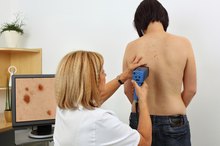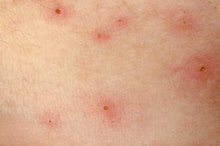What does fact checked mean?
At Healthfully, we strive to deliver objective content that is accurate and up-to-date. Our team periodically reviews articles in order to ensure content quality. The sources cited below consist of evidence from peer-reviewed journals, prominent medical organizations, academic associations, and government data.
The information contained on this site is for informational purposes only, and should not be used as a substitute for the advice of a professional health care provider. Please check with the appropriate physician regarding health questions and concerns. Although we strive to deliver accurate and up-to-date information, no guarantee to that effect is made.
Small Bumps All Over the Legs That Are Flesh Colored
Small, flesh-colored bumps on the legs may appear for a variety of reasons. Depending on their cause and location, they may cause no symptoms or they may itch, become irritated or spread to other areas of the body. Report any new skin growth to your doctor, as only a medical professional can accurately diagnose skin bumps and rule out skin cancer.
Types
Keratoacanthomas, keratosis pilaris, skin tags, warts and molluscum contagiosum account for most cases of flesh-colored bumps on the legs 24. Keratoacanthomas are round growths with a depression or crater in the center that holds a pasty substance. These bumps typically develop on the face, hands and forearms, but they may occur on the legs or other areas of the body. Keratosis pilaris are flesh-colored, slightly itchy bumps that develop on the upper arms, thighs and cheeks. The bumps feel like sandpaper and are sometimes mistaken for acne. Molluscum contagiosum is characterized by dome-shaped bumps with a dimple in the center, while skin tags are soft stalks of skin that normally appear in skin folds 4.
Causes
Earlobe Wart
Learn More
Keratoacanthomas are associated with sun exposure and arise from hair follicles in the skin, according to the New Zealand Dermatological Society. Following a minor injury, cells inside the hair follicle begin multiplying and form a mass. The mass then grows until it reaches its maximum size before disappearing. Keratoacanthomas are sometimes misdiagnosed as squamous cell or basal cell carcinoma because of their appearance.
Keratosis pilaris is a common inherited disorder associated with dry skin 2. According to the American Academy of Dermatology, the bumps of keratosis pilaris are actually skin pores plugged by an accumulation of dead skin cells 2. Warts and molluscum contagiosum are caused by a viral infection, and there is no known cause of skin tags, although friction may play a role in their development 4.
- Keratoacanthomas are associated with sun exposure and arise from hair follicles in the skin, according to the New Zealand Dermatological Society.
Treatment
Following biopsy to rule out malignancy, treatment of keratoacanthomas involves injections of corticosteroids and/or surgical removal, according to the University of Maryland Medical Center 1. Mild keratosis pilaris may respond to frequent application of moisturizers, but topical retinoids or mild chemical peels are generally required to get rid of the bumps, explains the American Academy of Dermatology 2. No treatment is necessary for flat warts, molluscum contagiosum or skin tags, although cryotherapy is effective at removing the growths for cosmetic reasons 4.
Considerations
Actinic Keratosis Vs. Seborrheic Keratosis
Learn More
Although a number of products are available over the counter to treat warts, skin tags and other skin bumps, these products are not always effective and may even be harmful with improper use. If you want to remove your skin bumps because they become irritated, are causing other symptoms or are cosmetically displeasing, contact a dermatologist for advice.
Warnings
Even small, flesh-colored bumps may be cancerous, notes the Merck Manual of Health and Aging. Any new growth or change in an existing bump requires immediate evaluation by a medical professional to rule out skin cancer. If your doctor suspects skin cancer, a sample of the bump will be removed for biopsy.
Related Articles
References
- University of Maryland Medical Center: Other Benign Skin Growths
- American Academy of Dermatology: Dry Skin and Keratosis Pilaris
- Keep Kids Healthy.com: Rashes
- CDC: Molluscum Contagiosum
- DermNet NZ: Keratoacanthoma
- Centers for Disease Control and Prevention. Molluscum Contagiosum. Updated May 11, 2015.
- Azevedo T, Catarino A, Ferreira L, Borges F, Mansinho K. Disseminated molluscum contagiosum lesions in an HIV patient. Cleve Clin J Med. 2017;84(3):186-187. doi:10.3949/ccjm.84a.16070
- Veraldi S, Nazzaro G, Ramoni S. Pubic hair removal and molluscum contagiosum. Int J STD AIDS. 2016;27(8):699-700. doi:10.1177/0956462415599491
- Rayala BZ, Morrell DS. Common skin cnditions in children: Skin infections. FP Essent. 2017;453:26-32.
Writer Bio
Sandra Ketcham has nearly two decades of experience writing and editing for major websites and magazines. Her work appears in numerous web and print publications, including "The Atlanta Journal-Constitution," "The Tampa Bay Times," Visit Florida, "USA Today," AOL's Gadling and "Kraze Magazine."









